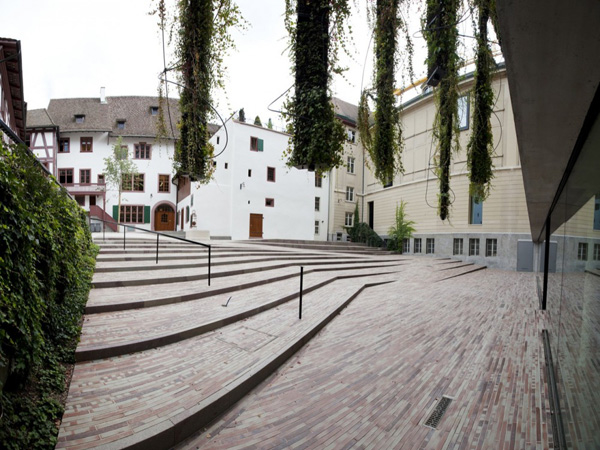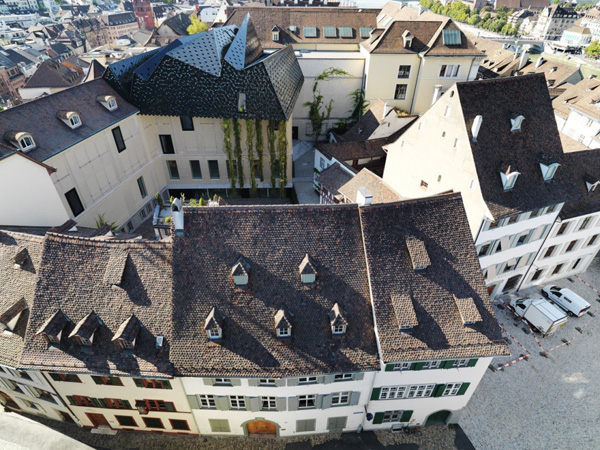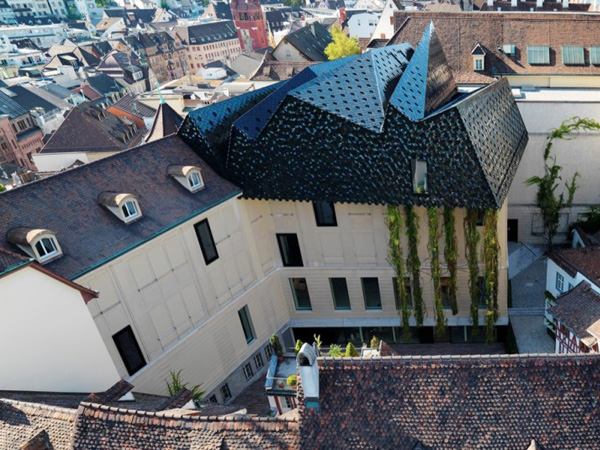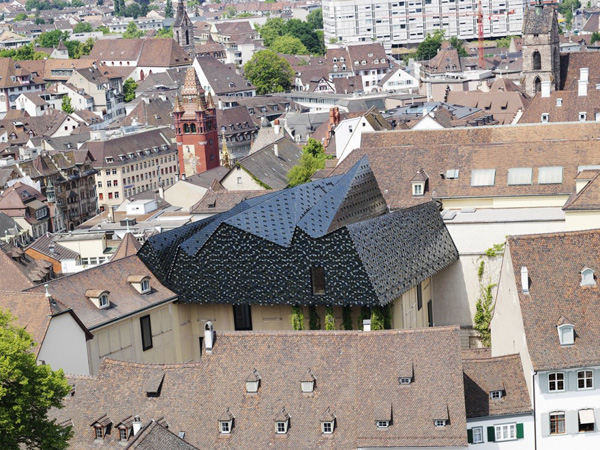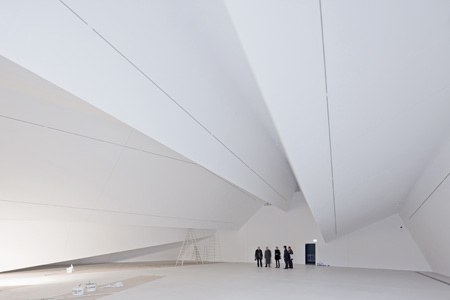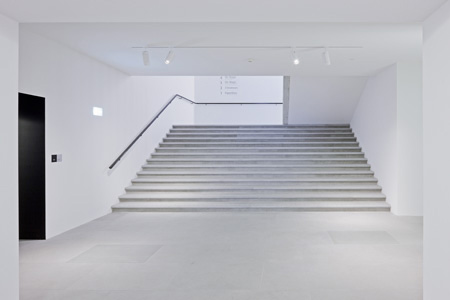Lokacija: Bazel, Švajcarska
Projekat: 2001.-2010.
Realizacija: 2008.-2010.
Arhitekti: Herzog & de Meuron
Partneri: Jacques Herzog, Pierre de Meuron, Christine Binswanger (Odgovorni partner)
Projektni tim: Martin Fröhlich (Saradnik), Mark Bähr (Glavni projektant)
Michael Bär, Béla Berec (Model), Giorgio Cadosch, Gilles le Coultre, Piotr Fortuna, Ines Huber, Volker Jacob, Jürgen Johner (Saradnik), Hamit Kaplan, Beatus Kopp, Laura Mc Quary, Severin Odermatt, Nina Renner, Nicolas Venzin, Thomas Wyssen
Površina lokacije: 2305m2
Površina postojeće osnove: 1209m2
Dimenzije proširenog objekta: dužina 29m, širina 27m, visina 10.5m
Bruto površina: 6350m2
„Etnografski muzej u Bazelu postoji od sredine devetnaestog veka. Klasicistička zgrada koju je gradio arhitekta Melchior Berri, otvorena 1849. godine, zamenila je manastir na mestu Münsterhügel. „Muzej Universal“, kako se tada zvao, bio je prvi muzej u gradu. Projektovan da prikaže i dela nauke i dela umetnosti, on danas ima jednu od najvažnijih etnografskih kolekcija u Evropi zahvaljujući pretežno čestim donacijama.“
„Horizontalno proširenje objekta značilo bi smanjenje površine dvorišta – Schürhof. Umesto toga objektu Vischer iz 1917. dodat je nov krov. Sačinjen od neregularnih nabora pokrivenih tamno zelenim, skoro crnim, keramičkim pločicama, krov se odnosi prema srednjevekovnom pejzažu krovova u koji je umetnut dok u isto vreme predstavlja jasan vid obnove u srcu naselja. Šestougaone pločice, neke od njih trodimenzionalne, prelamaju svetlost čak i kada je nebo oblačno, stvarajući efekat sličan onome koji imaju fino obrađene pločice od opeke na krovovima starog grada. Čelična struktura krova omogućava formiranje galerijskog prostora ispod krova koji je oslobođen od stubova – ekspresivnog prostora koji je drugačiji u odnosu na pravougaone galerije na spratovima ispod.“
„Sve do danas, Muzej kulture (Museum der Kulturen) i Prirodno-istorijski muzej (Naturhistorisches Museum) delili su zajednički ulaz iz ulice Augustinergasse. Sada je pristup omogućen direktno sa Münsterplatz trga preko prethodno nedostupnog dvorišta Schürhof. Ovo dvorište, u ambijentu zaleđa srednjevekovnih zgrada, postalo je produžetak trga Münsterplatz. Deo dvorišta je spušten i postavljene su široke stepenice, blagog nagiba koje vode do ulaza u Muzej. Viseće biljke i loze penjalice daju dvorištu specifičnu atmosferu i, zajedno sa krovom definišu novi identitet Muzeja. Raduje nas transformacija ovog dvorišta u mesto okupljanja za sve muzejske aktivnosti i proslave.“ Herzog & de Meuron, 2011.g.
Location: Basel, Switzerland
Project: 2001-2010
Realization: 2008-2010
Architects: Herzog & de Meuron
Partners: Jacques Herzog, Pierre de Meuron, Christine Binswanger (Partner in Charge)
Project Team: Martin Fröhlich (Associate), Mark Bähr (Project Architect)
Michael Bär, Béla Berec (Model), Giorgio Cadosch, Gilles le Coultre, Piotr Fortuna, Ines Huber, Volker Jacob, Jürgen Johner (Associate), Hamit Kaplan, Beatus Kopp, Laura Mc Quary, Severin Odermatt, Nina Renner, Nicolas Venzin, Thomas Wyssen
Site Area: 2305sqm
Building Footprint: 1209sqm (existing)
Building Dimensions Extension: Length 29m, Width 27m, Height 10.5m
Gross Floor Area (GF): 6’350 sqm
„The Museum der Kulturen Basel goes back to the middle of the nineteenth century. Replacing the Augustinian monastery on the Münsterhügel, the classicist building by architect Melchior Berri opened in 1849. The “Universal Museum”, as it was then called, was the city’s first museum building. Designed to house both the sciences and the arts, it now holds one of the most important ethnographic collections in Europe thanks largely to continuing gifts and bequests.
„Extending the building horizontally would have meant decreasing the size of the courtyard, the Schürhof. Instead the Vischer building of 1917 has been given a new roof. Consisting of irregular folds clad in blackish green ceramic tiles, the roof resonates with the medieval roofscape in which it is embedded while functioning at the same time as a clear sign of renewal in the heart of the neighborhood. The hexagonal tiles, some of them three-dimensional, refract the light even when the skies are overcast, creating an effect much like that of the finely structured brick tiles on the roofs of the old town. The steel framework of the folded roof allows for a column-free gallery underneath, an expressive space that forms a surprising contrast to the quiet, right-angled galleries on the floors below.
„Up until now, the Museum der Kulturen and the Naturhistorisches Museum shared the same entrance on Augustinergasse. The former is now accessed directly from Münsterplatz through the previously inaccessible rear courtyard, the Schürhof. The courtyard, in its patchwork setting of the backs of medieval buildings, has now become an extension of the Münsterplatz. Part of the courtyard has been lowered and an expansive, gently inclined staircase leads down to the Museum entrance. Hanging plants and climbing vines lend the courtyard a distinctive atmosphere and, in concert with the roof, they give the Museum a new identity. We look forward to having the courtyard become a social meeting place for all kinds of Museum activities and celebrations.“
Herzog & de Meuron, 2011



